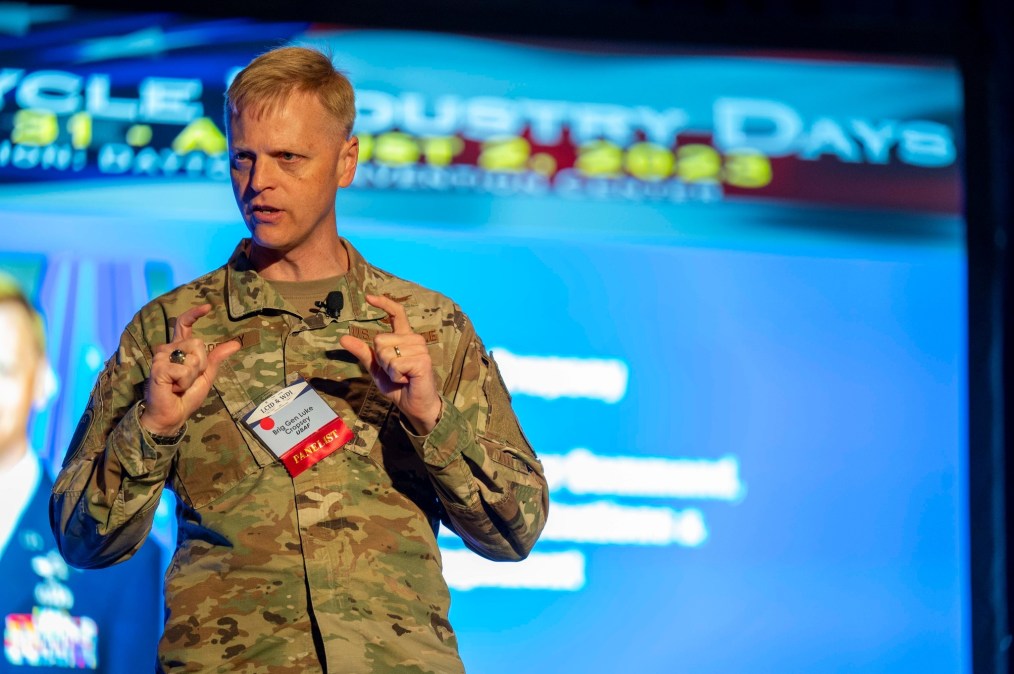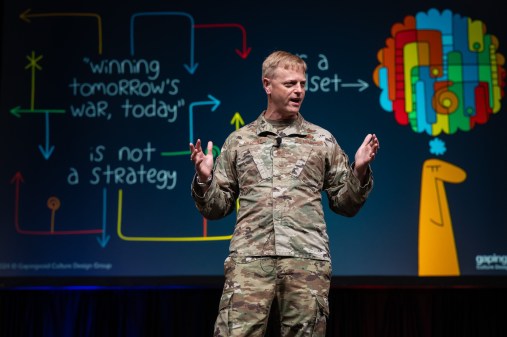‘One piece at a time’: How Brig. Gen. Cropsey is trying to simplify the Air Force’s JADC2 efforts

DAYTON, Ohio — As he leads the Air Force in modernizing its command, control, communications and battle management enterprise (C3BM), Brig. Gen. Luke Cropsey is trying to keep it as simple as possible.
Last September, Cropsey was named the service’s first ever integrating program executive officer for C3BM — initially described by Secretary of the Air Force Frank Kendall as “the hardest acquisition job I’ve ever given anybody” — and took the helm of the Department of the Air Force’s contributions to a Pentagon-wide effort known as Joint All-Domain Command and Control (JADC2). The concept seeks to connect the U.S. military’s many sensors and shooters under a single network to enable faster and more effective command and control.
For the Air Force, Cropsey is in charge of proving out and integrating the DAF Battle Network and the dozens of programs underneath it — a role that didn’t exist before he took the job, he told DefenseScoop.
“We had different entities that were responsible for different parts of the kill chain … There was nobody that actually owned the end-to-end acronym to make sure that it all would stitch together and it would all operate at the speed and at the scale that was going to be needed,” Cropsey said Aug. 1 during an exclusive interview with DefenseScoop on the sidelines of the Air Force’s Life Cycle Industry Days in Dayton, Ohio.
After almost a year into the job, Cropsey described his approach as taking simple yet focused actions in order to rapidly acquire new capabilities that the Air Force can continue to iterate off of. At the same time, there’s still a need to be dynamic and flexible — both in terms of technology and acquisition.
“We’re taking it one piece at a time,” he said.
Dealing with complexity
During a roundtable with media at the Life Cycle Industry Days, Cropsey described two critical lines of effort under the DAF Battle Network: building a command-and-control architecture and its underlying digital infrastructure.
“People use the ‘architecture’ word and things start to get fuzzy and people’s eyeballs roll up in their head,” he told reporters. He described the architecture they’re building out for the DAF Battle Network as the relationships between the various components and capabilities within a system.
“In this case, that ‘system’ is that warfighting apparatus that we need in order to be able to affect the outcomes in a wartime environment,” Cropsey explained.
The Air Force’s architecture components are managed by Bryan Tipton, DAF C3BM chief of architecture and engineering. Tipton inherited many programs from former Chief Architect of the Force Preston Dunlap, who was first tasked to oversee the Air Force’s JADC2 efforts in 2019 before resigning.
The portfolio historically encompassed a broad range of capabilities, but now it’s acutely focused on specific operational outcomes related to C3 modernization, Cropsey said.
“If you think about the problem everywhere, all the time, in any context — you choke on it. It’s just too huge,” he said. “The way that you deal with that complexity is by being very focused around the particular operational outcomes that you have to achieve, and then re-weighting the things that you have available, … all the parts and pieces and people that you need to connect together in order for that outcome to be achieved. That’s an architecture.”
Getting specific and contextualizing the problem allows Cropsey and his team to assess the DAF Battle Network’s architecture from both a technical and programmatic perspective, while also addressing detailed questions on capability delivery timelines and technology gaps, he added.
As for the digital infrastructure, many of those efforts are tied to the Advanced Battle Management System (ABMS) formerly under the Department of the Air Force’s Rapid Capabilities Office and touch on connectivity, compute and processing needs.
“The architecture would explain how the different things that are in the system use and relate to that infrastructure,” Cropsey said. “The infrastructure is part of the architecture, but it provides kind of the backbone that all the things that are in that architecture need in order to communicate and connect to each other.”
Cropsey’s focus there is keeping those efforts moving down the development pipeline, with plans to start deploying digital infrastructure capabilities soon. He told DefenseScoop that his team is currently taking advantage of the concurrency of both the architecture and infrastructure efforts now under program executive office for C3BM.
“Regardless of what the architecture team generates, I already know I have to have this connectivity in order to put all those pieces together,” he said. “So at very low risk of duplicating something or buying something that’s not going to be usable, I can move out in parallel on this not very sexy — but really, really important — underlying infrastructure that has to be available.”
This helps define the fixed endpoints of the architecture that are essential to get right the first time around, as well as inform where across the rest of the architecture the Air Force can be a bit more flexible with capability, Cropsey said.
“At some point we can converge all those things, where I have those clear architectures [and] they’ve got well-defined endpoints,” he said. “Now that’s cooking with gas. Now you have the ability to do [C2] at scale, at speed — the sky’s the limit.”
Turning the system on its head
When considering how the Air Force should start acquiring and fielding JADC2-enabling capabilities for the DAF Battle Network, Cropsey said he is certain of at least one thing: “The way that we’ve done it historically isn’t going to work.”
Cropsey told DefenseScoop that in the past, designing a system as complex as the DAF Battle Network from a clean sheet of paper hasn’t worked. He’s trying to pivot away from traditional experiment and acquisition strategies and instead focus on 90-day “sprints” that allow for capabilities to continuously and gradually deployed over time.
It’s an approach that essentially turns the entire system on its head, he said.
“There’s a clear deliverable, a clear capability that’s coming out on a regular, repeatable kind of basis and we’re using that time-certain imperative here to really pressurize the system into not doing big-bang acquisitions,” Cropsey said. “You don’t have time to go make this really complex, high-end [product]. You’ve got to get to a working capability now, so make it simple and make it work.”
The goal is to deploy the simple and proven technologies first, then slowly iterate and build off of those over time until the Air Force gets to the more complex and evolved capabilities, he said.
Still, this requires more than the right capabilities. The department also needs a culture and program office that are aligned with the concept and can do more than manage the technology, Cropsey noted.
“They’ve actually got to be technically competent enough to be in the actual wiring diagram of how we’re going to get this thing done,” he said. “I need people that can code, I need people that can actually see where and how the trajectory is moving, recognize where it needs to get adjusted in real time and do the work.”
He pointed to the Air Force’s cloud-based command and control (CBC2) capability release as proof that the service can take a fundamentally different approach to contracting and fielding modern C2 capabilities and be successful. The program combines a variety of air-defense data sources for U.S. Northern Command and the North American Aerospace Defense Command (NORAD) to enable faster decisions for homeland defense.
Rather than having a single prime contractor, Cropsey said his office is managing “tens of different contract vehicles just for that one effort.” CBC2 will reach initial operational capability by the end of fiscal 2023, he said.
While the CBC2 capability release was well executed, the Air Force’s other effort, known as Capability Release 1, had its hiccups.
The initial plan announced in 2021 was to field at least four communications prototypes for the KC-46, allowing the tanker to link the F-22 and F-35 fighter jets — where were previously incompatible comms-wise — as well as ground-based command-and-control systems. That effort has since been scaled back and now focuses only on getting an organic communications capability onto the KC-46 so it can effectively do its mission, Cropsey said.
The pivot was in response to Air Mobility Command’s insistence that connectivity on the KC-46 was absolutely essential, he added.
“Because the timing is so critical of getting that capability in place and out to them, we’ve narrowed the scope down to getting that initial palletized capability into the back of the KC-46 and then given them the opportunity to start experimenting with a couple of different ways, [concept of operations-wise], that they could start using that as kind of a basis for that capability,” Cropsey said.
It’s an attempt to leave things behind in a meaningful way that favors getting new capabilities into the operational environment, he noted. That strategy requires constant communication between his team and the operational users.
“If we aren’t staying tight at the hip, and we aren’t moving at the same rate of speed with our operational counterparts in this or where the technology is moving, we’re gonna get left behind and we’re gonna end up with yesterday’s technology, tomorrow. That’s not a winning strategy,” Cropsey said.
Moving forward, Cropsey said he isn’t afraid to pivot away from the capability release strategy and consider other approaches to deploying C2 capabilities if he needs to.
“I am not overly constrained by how we’ve done it,” he said. “I’m much more interested in what we have to do to succeed moving forward.”






